Prison City is a retro action-platformer that embraces the narrative cliches, design tropes, and visual aesthetics of movies and videogames that were popular in the 1980s. I play as Hal, a retired police officer who is recalled to duty by his former Chief to infiltrate Detroit, the troubled city which was converted into a megaprison after it was abandoned by its citizens. Hal’s mission is to track down and assassinate nine leaders who have organized the prisoners into a dangerous army of technoterrorists. I guide Hal across ten levels of running, jumping, and projectile-tossing action to save the United States of America from an army of its own making.
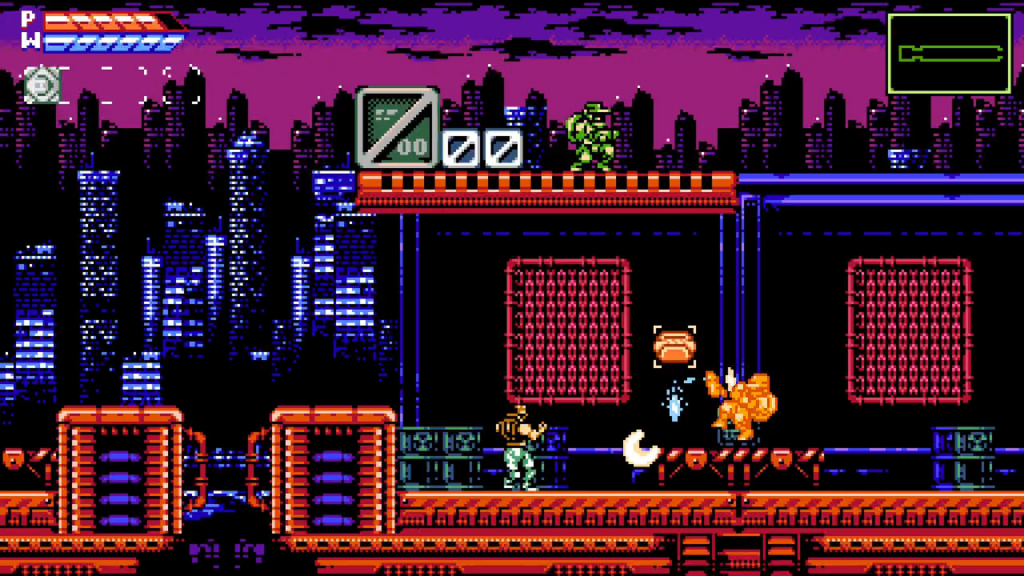
Prison City revels in its retro design and outdated values. I sense this immediately from its plot, a pastiche of films like Rambo: First Blood Part II, Escape from New York, Robocop, and any number of cowboy cop movies that were popular in the 1980s. The story is told through communication windows modeled after those found in Metal Gear—which itself borrows many of its ideas from 1980s action films—with a sense of humor that suggests a gentle affection for its inspirations. Hal encounters a twelve year old genius scientist, a robot, and a talking dolphin in Detroit, and if he finds any of these characters unusual I will never know. He responds to all with a taciturn indifference that parodies the one-note heroes he is modeled after. His straight man act remains humorous all the way to the credits, lasting much longer than I expect.
This same era is recalled in Prison City’s 8-bit-inspired retro graphics. The predominant color throughout most levels is black, reminiscent of a time when many videogames had lots of empty black space because it was the simplest color to render with limited storage and computing power. Other background elements contrast the darkness with bright colors, turning Detroit into a blasted ruin soaked in neon and gunfire that feels quintessentially 1980s.
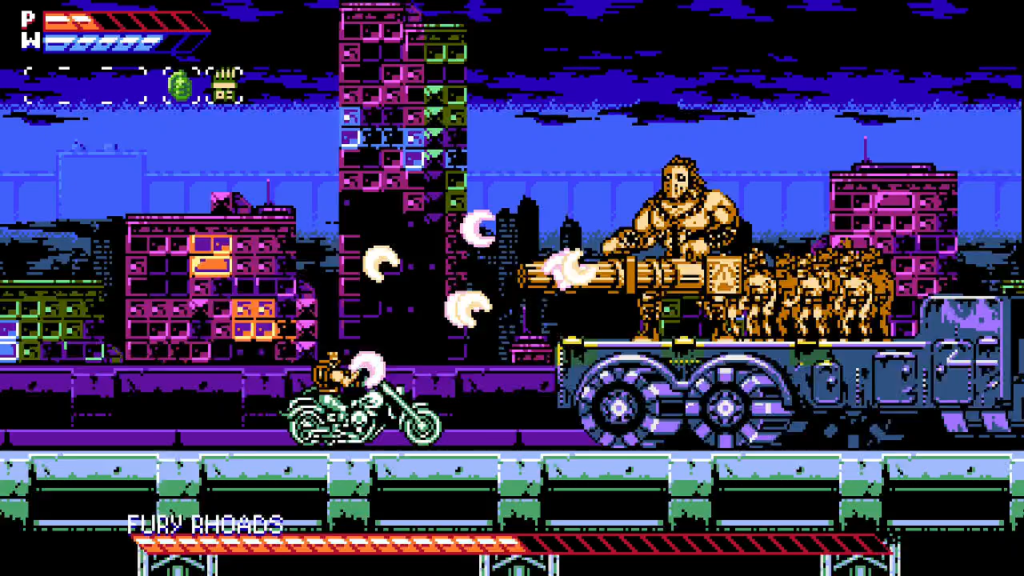
Character models similarly echo the era. Player character Hal has the most visually complex model using a whopping four colors, not counting black. He wears blue pants and a brown vest that helpfully matches his hair color. Most other character models use two similar shades of one color, giving a hint of depth and texture while keeping their appearance as simple as possible. Even a boss battle that fills the screen with a towering gun-toting gang leader and his army of minions renders them all in just two shades of brown.
Taken collectively, all these visual elements help sell Prison City as an authentic product of a particular time in history. It’s the kind of videogame that wants to be indistinguishable on a shelf alongside NES videogames like Bionic Commando, Shadow of the Ninja, and Vice: Project Doom. Its secret is its technical aspects would cripple that poor console.
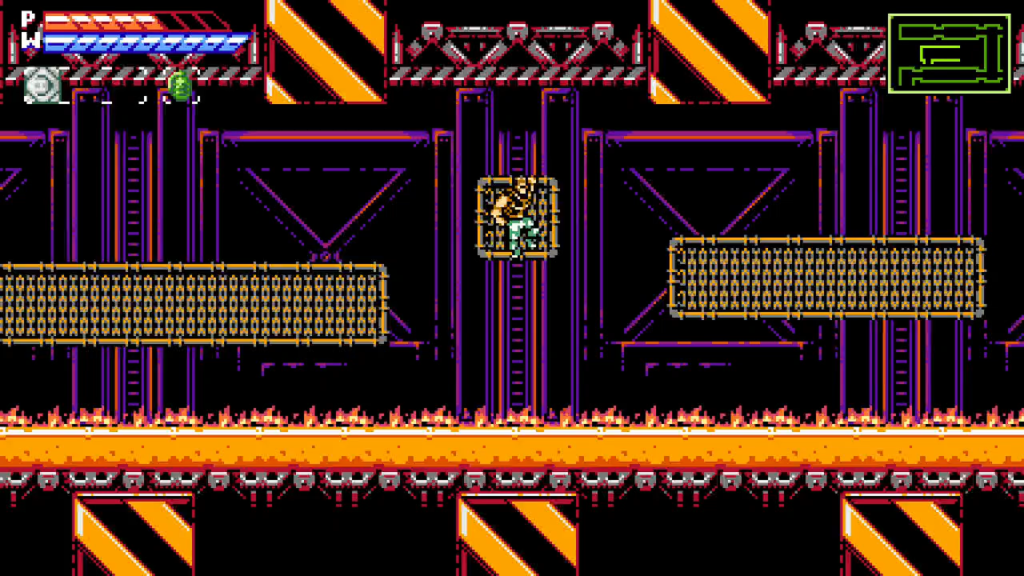
At first I am bemused to discover that Prison City includes a tutorial for controlling Hal. I’ve played many action-platformers and feel that few need tutorials. Yet this tutorial exists for good reason. Hal has a surprisingly robust and nuanced moveset for the protagonist of an 8-bit action-platformer. No matter how confident I might feel about my skills, I would have been lost without first playing this tutorial.
What might have left me stuck the longest is Hal’s acrobatic skill. Detroit is filled with bars and fences which Hal can cling to and climb upon. Many obstacles can only be overcome by jumping along a series of bars or climbing along a fence suspended from the backdrop. Hal clings to these objects when I press and hold the jump button as he passes by them. This feels counterintuitive at first. I send Hal plummeting down a few pits when I expect him to grasp a bar automatically—luckily this only makes him respawn on a nearby platform with one less hit point on the default difficulty. After about an hour I learn, and by the final boss holding down the jump button to grab an outcropping feels like second nature.
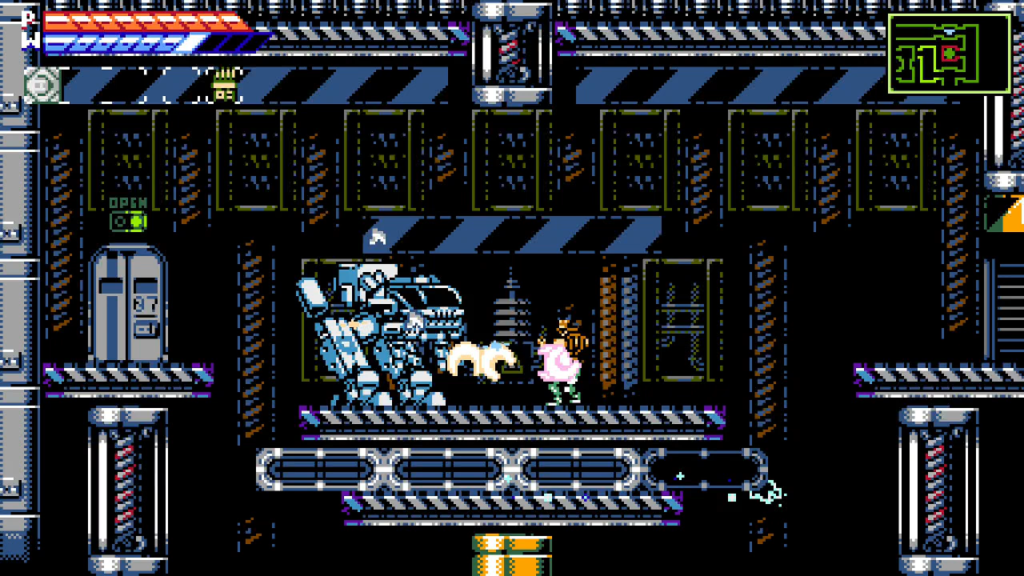
Despite being a cop, Hal’s weapon for his mission is a nonsensical arsenal of energy chakrams that fly forward a short distance then loop back to his hands. He can throw chakrams as fast as I can press the attack button but an energy meter limits their damage potential. The meter replenishes in a fraction of a second, but throwing chakrams too fast can still drain it, bottoming out the damage they deal. This system encourages me to find a quick-but-steady rhythm of button presses that is only slightly more interesting than rapid mashing. The tutorial also teaches me how Hal can suspend a single chakram at the end of its loop and revolve it around himself in an arc. I find just one obstacle that requires this ability at the end of an optional bonus level, though more creative players than I may find it has unorthodox applications.
Prison City’s first level is always the same, depicting Hal infiltrating Detroit on a train filled with weapons and supplies for the technoterrorists. From there I can choose from the next batch of eight levels Hal will visit in any order I want.
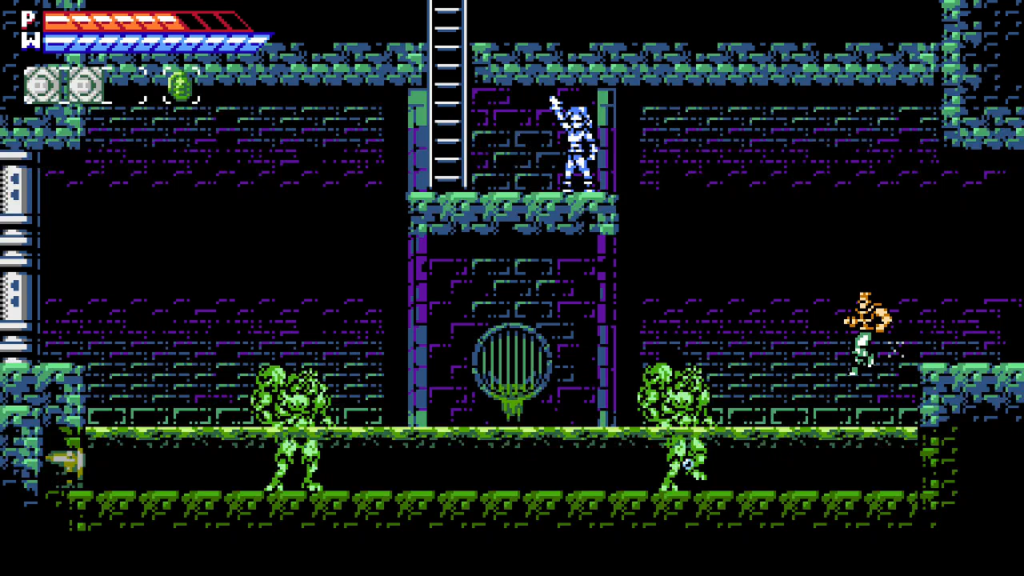
Many of these levels take advantage of the Detroit setting. One level is set across the city rooftops. Another ventures into exaggeratedly spacious sewers which are also filled with toxic waste and mutant monsters, because of course. A memorable level takes place along a crumbling freeway, a large section of which Hal navigates in a scrolling motorcycle sequence. Perhaps the best idea for a level is a stadium filled with sports-themed enemies, culminating in an epic showdown on the playing field before a packed audience.
Prison City does not let Detroit’s real-life geography be an obstacle to exploiting familiar tropes from the design era it homages. There is a jungle level and an ice level. Some expository lip service is paid to explain how these unlikely environments fit into Detroit’s urban blight, but I know the real reason: It’s just not a NES videogame without an ice level, no matter how illogical its presence is within the story and setting.
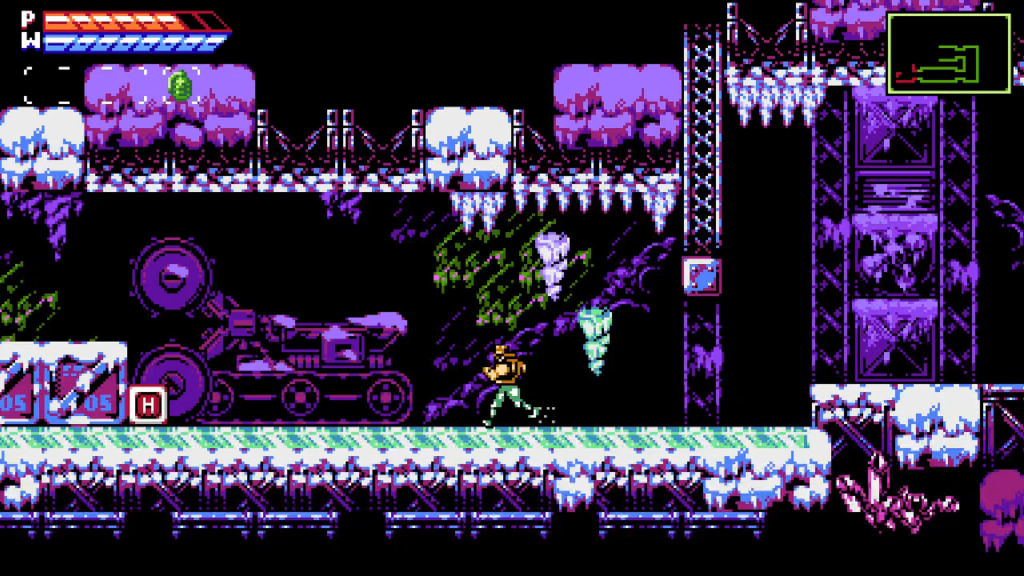
Though I am told that Detroit is home to innumerable inmates who have been radicalized and recruited to be technoterrorists, Hal spends as much time fighting drones, turrets, and robots as he does ordinary people. This is silly but in keeping with Prison City’s 8-bit inspirations, whose protagonists often find themselves fighting swarms of whatever random monsters their creators can dream up. The unusual enemy composition also helps me set aside questions like “who are these prisoners” and “why were they sent here.” Like the righteously violent antiheroes with a badge whose memory Hal conjures, I am not meant to be troubled by such thoughts.
The goal in most levels is to find a local informant who gives Hal a key that opens the door to that area’s terrorist leader. This idea necessitates most levels having open-ended design. They’re not large enough to be called sandboxes, but there is nothing preventing Hal from running all the way back to a level’s entrance if I choose to take him there. Often Hal finds the boss’ door right away but must push to the levels’ furthest edges to find the informant carrying the key. In other levels, the informant is in plain sight early on, but Hal must take a circuitous route to reach them.
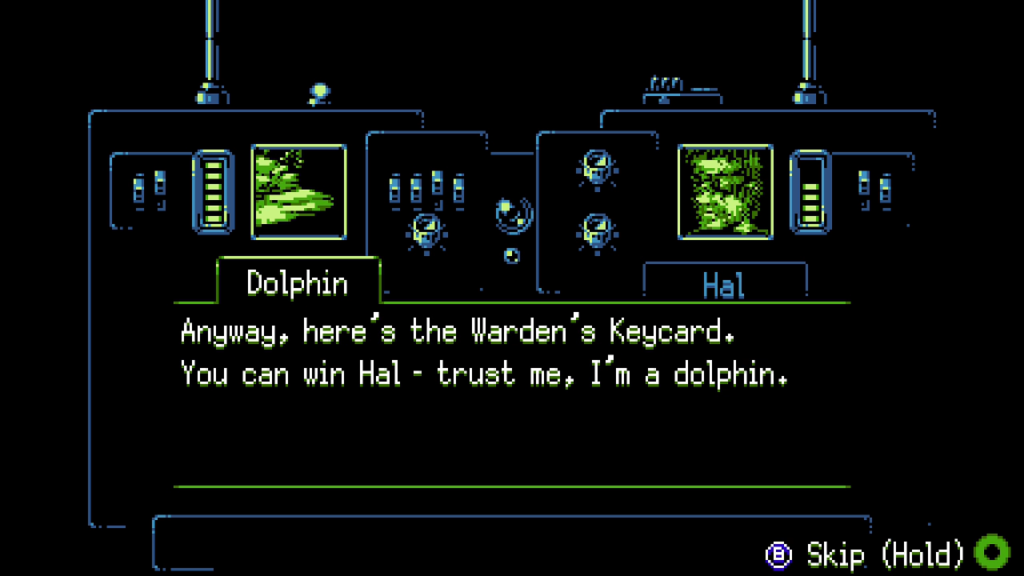
The exception is the final level, a sprawling labyrinth incorporating elements of every previous level. It has unique goals that really take advantage of the open-ended level design. It takes me over an hour to finish, a quarter of the total time it takes me to beat Prison City. It overwhelms my memory of my experience and not necessarily in a positive way.
The open-ended level design is exploited in at least one interesting way: Each hides a small upgrade for Hal’s life and chakram energy meters. These upgrades are secreted away in rooms accessed through hidden passageways. Most of these passageways are in plain sight, but made easy to miss through tricks in visual design. A section of empty black space may appear to be part of the backdrop, but is actually a narrow tunnel which Hal can slide through. Other passages are hidden behind breakable walls or through geography that appears solid but is not. I quickly deduce most of the tricks used to hide these passageways and don’t have any difficulty locating every upgrade on Hal’s first visit to a level. They are rewards for extra effort, not secrets meant to make one hundred percent completion a vexing and illusive goal.
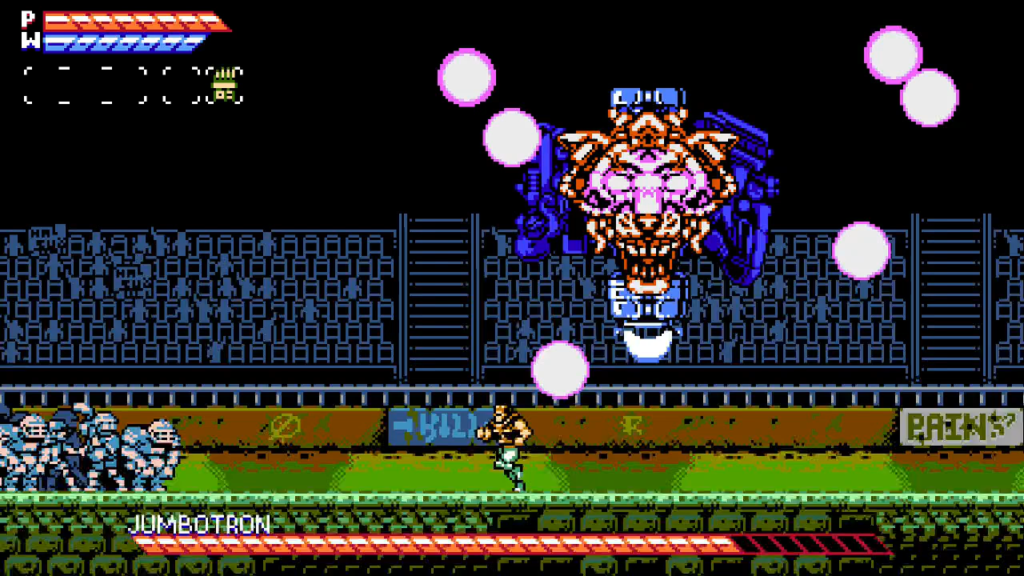
Each level culminates in a battle with one of Detroit’s technoterrorist leaders. Like the standard enemies, they are a confoundingly random collection of ordinary people, robots, and superweapons guided by invisible pilots. A Hind D chopper feels out of place in Detroit, but still makes sense with the themes and era Prison City draws from. A floating head with four rotating faces, each one equipped with a unique weapon, is awesomely ridiculous, and made moreso for calling it a Jumbotron and placing it as the Stadium boss. Mistress Drosera, a woman who shields herself inside a monstrous flower blossom and assaults Hal with giant razor-sharp plant stems, feels like she got lost on her way to a completely different videogame. Their designs are delightfully eclectic, fitting together only in how they don’t fit together at all.
The platforming challenges and enemy configurations in Prison City are of a mild difficulty. Its bosses are another matter. None of their patterns are long or intricate; they are not difficult to learn. None of them deal much damage. What they are is incredibly fast. Even when I know what’s coming, it’s often difficult to move Hal out of the way in time to avoid the attack. Each boss takes practice and persistence that can feel dismaying when compared to Prison City’s otherwise mild difficulty.
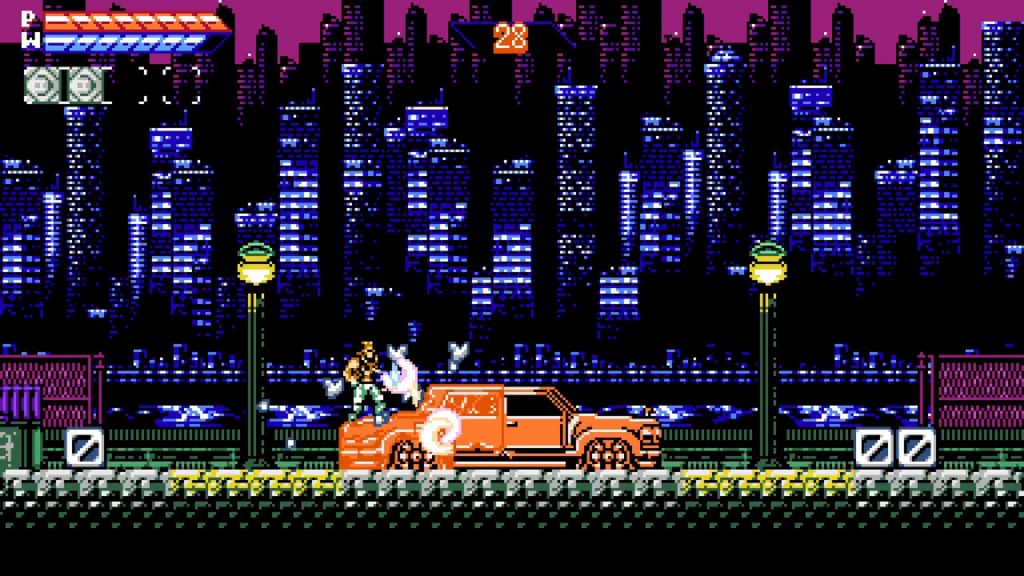
The solution I find to boss difficulty is to farm extra lives. Several levels culminate in recreations of famous scenarios in classic videogames, such as defusing underwater bombs surrounded by electric seaweed or breaking all the targets in an obstacle course. Successfully completing these challenges rewards Hal with three extra lives and once I have finished their associated level, I may replay a challenge as many times as I want from the level select screen. The car smashing challenge may be finished in about twenty seconds, so it only takes a few minutes of hurling Hal’s chakram into some poor guy’s car to stockpile a few dozen extra lives. This safely buffers Hal against a potential game over to a challenging boss fight.
If Prison City’s boss challenges do become too difficult for me, I can take advantage of its multiple difficulty levels. The Easy difficulty gives Hal infinite lives and otherwise makes many of its systems easier to confront. After I’ve defeated the technoterrorist army on the default difficulty, I can challenge the Classic difficulty. It removes some of the quality-of-life features that have become expected niceties in retro platformers, most notably Hal teleporting to a nearby platform when he falls down a pit. On Classic difficulty, in classic NES style, a fall down a pit costs Hal an extra life.
After the credits have rolled I also unlock a new mode that remixes the level goals. An extra difficulty level and a remixed campaign are not the most robust suite of features to keep me engaged with a videogame after I’ve beaten it, but it does provide a decent enough reason to replay the campaign at least once.
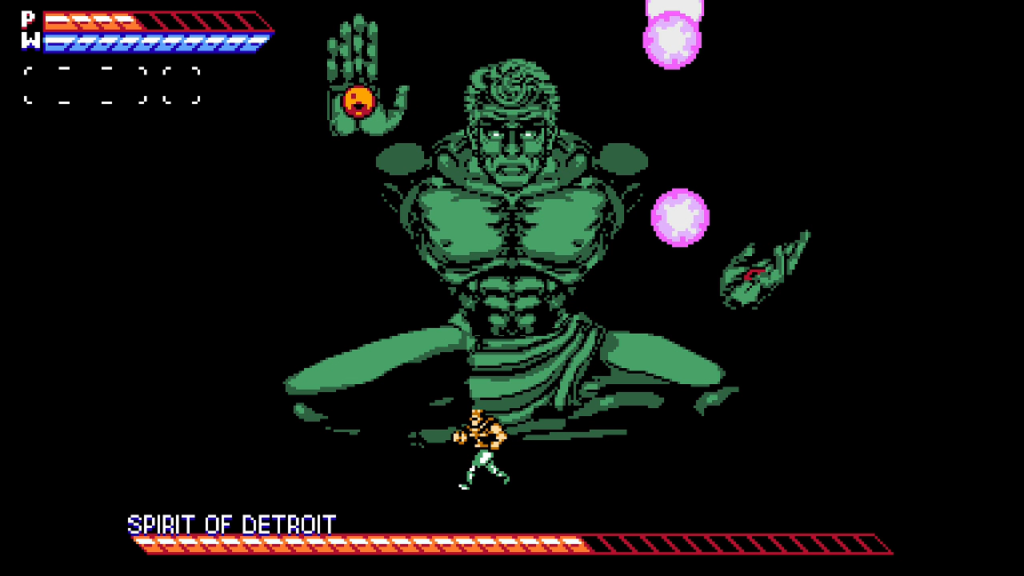
Prison City’s greatest strength is its sense of authenticity. If I didn’t know better I would believe it is a classic 8-bit action-platformer, resurrected and polished for current audiences. Only its knowing sense of humor gives away its true self; it treats tropes and cliches with too much affection to be anything but a love letter from decades in the future. If this were truly a relic from the 1980s it would play these elements straight. For a short, sub-five hour retro platforming experience that delivers fair amounts of fun, challenge, and nostalgia, Prison City is one of the better options of recent years.